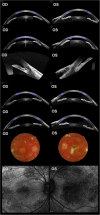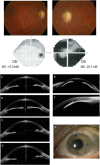A new paradigm for delivering personalised care: integrating genetics with surgical interventions in BEST1 mutations
- PMID: 31455904
- PMCID: PMC7042240
- DOI: 10.1038/s41433-019-0553-5
A new paradigm for delivering personalised care: integrating genetics with surgical interventions in BEST1 mutations
Abstract
Background: The availability and reduced cost of genotyping has improved gene susceptibility testing and our scientific understanding of disease pathophysiology. Whilst several personalised translational models exist within medical frameworks, genetic-based surgical therapy is a translational application not widely used in surgical specialties.
Method: We present a clinical series of five patients with genetically confirmed bestrophinopathy and malignant glaucoma (MG). Patients were followed up for 12 months or more after receiving surgical intervention to manage refractory intraocular pressure (IOP) resistant to medical treatment.
Findings: Patients with BEST1 gene mutations are at higher risk of MG after filtration surgery. A multi-disciplinary approach after four patients experienced poor outcomes concluded that traditional first-line glaucoma surgery was not sufficient to prevent visual loss. A fifth patient presenting with the identified at-risk phenotype underwent primary pars plana vitrectomy, with pars plana Baerveldt tube insertion, successfully preventing MG and had no glaucoma progression after 5 years.
Interpretation: We provide proof-of-principle that genetic analysis can be used to inform the selection of surgical therapy to improve outcomes. In this case, a refinement of current surgical methods to avoid MG. Although challenges remain, personalised surgery has the potential to improve clinical outcomes beyond the scope of current surgical practice.
Conflict of interest statement
The authors declare that they have no conflict of interest.
Figures



References
-
- Personalized Medicine Coalition. Personalized medicine at FDA: progress report. Personalized Medicine Coalition. Washington; 2018.
-
- Personalized Medicine Coalition. The personalized medicine report: opportunity, challenges, and the future. Personalized Medicine Coalition. Washington; 2018.
-
- Ellen Graham. Improving outcomes through personalised medicine. NHS England. England; 2016.
-
- Stevelink Remi, Sanders Maurits WCB., Tuinman Maarten P., Brilstra Eva H., Koeleman Bobby PC., Jansen Floor E., Braun Kees PJ. Epilepsy surgery for patients with genetic refractory epilepsy: a systematic review. Epileptic Disorders. 2018;20(2):99–115. - PubMed
MeSH terms
Substances
LinkOut - more resources
Full Text Sources
Medical
Miscellaneous

